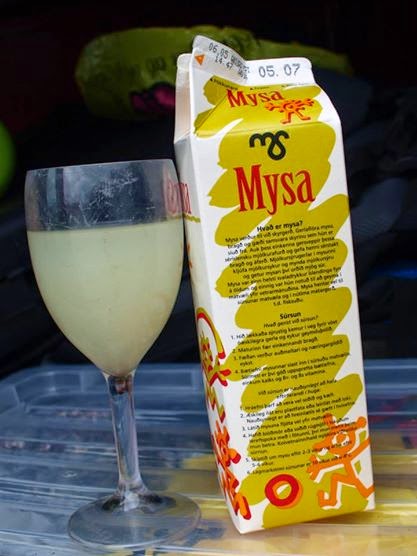Tiny Iceland, a country of some 350.000 viking souls have their own way of celebrating the tongue and stomach. During my trip there i got to test a few of them Testing the local fare is mandatory in my eyes. And when travelling locally, self catering, this testing comes naturally all by itself.
 |
| Black death beer. One just HAVE TO try something with a label like this. It is a stout brewed by the Viking Olgerd brewery in Akureyri. |
 |
| Iceland boast a good selection of good local brew. Sort of surprising considering beer was illegal on Iceland from 1915, right up to 1989. On march 1st that year, beer was finally made legal and since then 1st of march has been celebrated as beer day. The newest on the Icelandic beer front is a beer containing whale meat. Stedji brewery has teemed up with a whaling company-and not surprisingly they are not popular in many circles. |
 |
I consider the Icelandic nation to be a clever one. They know to make use of their resources. This becomes evident in the selection of liquors made on Iceland, based on locally available ingredients. Some of the bigger Vinbudin stores (the Icelandic alcohol shops) have a good selection. The Icelandic Fjallagrasa schnapps, brewed on moss which is soaked in alcohol to extracts the flavours and aromas. No artificial substances are added. This moss was formerly used both as a food source and for medical purposes. Brennivin-also nicknamed Black death-Svarta daudir in Icelandic-is one of the Icelandic icons. The base ingredient is mashed potato, flavour comes from cumin, caraway and angelica. All of which can be found on Iceland. This liquor is a must s a complement to another Icelandic icon-the putrefied sharkmeat. When i travelled on Iceland-Brennivin was in my luggage at all times. Like the scouts: Always prepared and ready!
One of the Icelandic companies i love the most is the 64 degree Reykjavik distillery. They produce a wide selection of liquors based on local ingredients. And they are all good. Crowberry or rhubarb schnapps. Blueberry liquor. Juniper schnapps......many varieties. On the picture above-its birch scnapps is shown. Also part of my travellers bar. |
 |
| Sharkmeat drying in a shed at Bjarnarhofn farm, a major producer of hakarl. They have produced it for generations, and have opened a museum showing the process. At the museum there is also a display of tools previously used in sharkfishing-including a boat. So you get both the present and the history. Hakarl has been a food source on Iceland for a few hundred years, the idea born out of necessity. Sharks are not caught specifically for this trade-sharks that ends up in nets and trawls are used instead of throwing it away. The meat is to start with downright poisonous to humans due to the high ammonia content. This was traditionally taken care of by bury the meat in the ground for months.-now it is stored in plastic containers. After having "matured", the flesh is hanged and dried for months before it is ready to be enjoyed. And it is done with a mandatory shot of the above mentioned Brennivin. As to what the hakarlexperience is like.....lot of people would never consider a second round. It does smell. It does taste weird-but actually i did like it, and i bought it frequently during my 3 months in the country. |

Svid-sheep head-is rooted in a time when nothing could be wasted. You get half heads with the fur and the brain removed. My source of this dis was supermarkets where it actually was delivered glowing hot and ready to eat on the spot. I find it good-but it is somewhat strange when the food look as you.....On Iceland they have something they call thorramatur-often a buffet of traditional foods. Sheephead, shark, dried fish and liver sausage are mandatory ingredients-together with-of course-Brennivin. I found the liver sausage together with blood sausage to be perfect with both schnapps and Brennivin.
 |
| Birkisirop, from the sap of birches is Icelands native answer of the north American maplesyrup. Contrary to what many people believe, there is some forest on Iceland-and it is getting more year by year. Still, this is a new product on Iceland-the inspiration apparently came from Finland. The method of extraction is the same as for the more known maplesyrup. A hole is drilled in the trunk, a tap is inserted and then it is only to wait for the liquid to drip. A single tree give 1-6 liter of sap every day-but only 40-60 liters is taken from each, and after a season of harvesting, it get to rest a few years. |
 |
| Fjallargros-dried moss, which together with dried Icelandic algae were used in my soups. |
Sold at every supermarket, Mysa (whey) is a sour but thirst quenching milky product. It is the fully usable rest product of the production of skyr, a delicious yoghurtlike product sold with many different flavours. Both have roots back to the viking era, but eventually was forgotten by most of the former viking world-except Iceland.
On Iceland they still make Hverabraud, It is a somewhat sweet and heavy rye bread which is baked underground, the heatsource is mother earth herself. It is relatively expensive compared to the normal rhyebread-rooted in Denmark.
Heartbreaking-but delicious. Horsemeat is readily available in the Icelandic supermarkets. The flavour is strong, and the met is clean with a nice texture because the horses live outside all year and are not fed with all sorts of shit. On iceland you can get horsesteak, horseburger, horsestew. It is popular meat and it is said the popes ban on consuming horsemeat slowed the introduction of Christianity on Iceland.








No comments:
Post a Comment